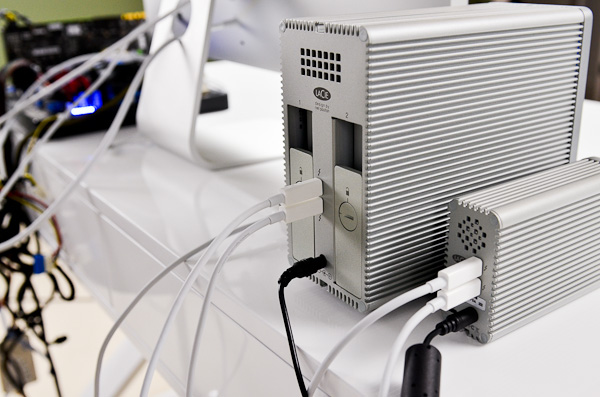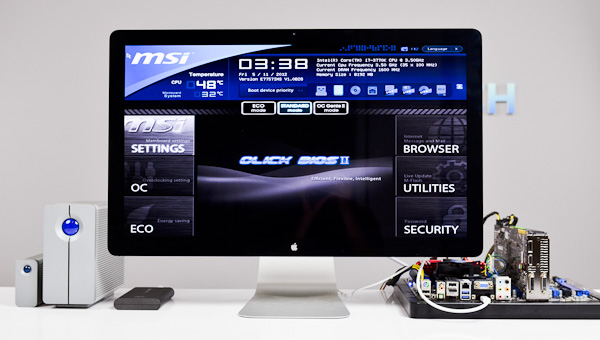A First Look at Thunderbolt on Windows with MSI's Z77A-GD80
by Anand Lal Shimpi on May 11, 2012 1:32 PM EST- Posted in
- Motherboards
- CPUs
- Intel
- MSI
- Thunderbolt
The Storage Devices & Performance
Other than Apple's Thunderbolt Display, every other TB device we've tested has been some sort of storage device. In my lab I've got Promise's Pegasus R6, LaCie's 2big and Little Big Disk (SSD), Seagate's GoFlex Thunderbolt adapter and Elgato's Thunderbolt SSD. With the exception of the Pegasus R6, which currently lacks Windows drivers, all of the storage devices I tested worked with MSI's Z77A-GD80 under Windows. Although there are workarounds for getting the Pegasus up and running under Windows, I encountered a number of hangs and general system unhappiness whenever I tried them on this platform. I suspect this has something to do with why Promise has yet to officially release Windows drivers for the Pegasus.
The rest of the storage devices, as you would expect, just worked. I didn't need to install any drivers as all of their internal controllers had native support under Windows 7. Again, I couldn't hot plug any of these devices once Windows was running - all of them had to be present at boot.
Just as I've seen under OS X, with complex Thunderbolt chains you'll sometimes have a device that hangs in the chain and prevents some or all TB devices from working. I did encounter this behavior more frequently under Windows than I did under OS X. Keep in mind that every single Thunderbolt device on the market today was pretty much developed and tested against Macs, it's going to be a little while before we get perfect behavior under Windows. We don't even have perfect behavior under OS X yet either. My hope is that as more platforms ship with Thunderbolt support, and as we get more Thunderbolt devices, compatibility and behavior validation will both improve. I've also heard that the early Thunderbolt controllers were more finicky than Cactus Ridge, so it's possible that newer TB devices that come out this year will just inherently be better behaved. This is purely hearsay however, I don't have any hard evidence to back it up.
Update: Intel tells us that an updated Pegasus driver is in the works that will address the issues we've seen. Other finicky behavior is also expected to be addressed through the Thunderbolt on Windows certification process.
Since I couldn't get the Pegasus working, I had to resort to combining a bunch of my other Thunderbolt storage devices to measure performance. I created a chain combining LaCie's 2big, the SSD Little Big Disk and Elgato's Thunderbolt SSD along with Apple's Thunderbolt Display. I ran a 128KB sequential read test at a queue depth of 32 across all of the drives, while pushing the Thunderbolt Display at its native 2560 x 1440 resolution:
The best I ever got under OS X was 8Gbps using four SandForce SSDs in the Promise Pegasus. At 7Gbps using a far less elegant setup, this isn't bad at all. Keep in mind that while we're reading at 7Gbps, the GD80 was also using around 7Gbps of bandwidth to drive the Thunderbolt Display at 2560 x 1440. Total available bandwidth for a single-port Thunderbolt device is 20Gbps bi-directional (40Gbps total), so there's still additional headroom available.
Moving Forward
MSI's Z77A-GD80 finally brings Thunderbolt to Windows desktops. With a few exceptions, the experience is quite similar to OS X. The major differences are that some devices clearly need more compatibility testing with these new platforms, and that you can't hot plug Thunderbolt devices under Windows. The former is solvable given additional time, while the latter can be more annoying in the long run if a workaround isn't found. For a single, high-speed storage device under Windows, USB 3.0 is going to be the simplest route. It's only when you want to start pushing even more bandwidth and/or add a display into the mix that Thunderbolt becomes your only solution.
Thunderbolt's functionality otherwise looks very similar under Windows as it does under OS X. The interface doesn't require any specific drivers and in the best conditions it just works. Thunderbolt's behavior remains quite finicky however, even more so under Windows. You'll want to wait for either the next generation of Thunderbolt devices or for the current device vendors to get some more time validating their Thunderbolt products on Windows platforms. Given that the first Thunderbolt equipped PC motherboards haven't even shipped yet, you've got some time.
Update: Intel has informed us that we will see updated drivers for Windows certified Thunderbolt devices that will enable hot plugging under Windows. Intel further informed us that MSI's board has not yet made it through the certification process and a lot of these teething issues will hopefully be addressed by then.
For much of the past year I've been calling for cheaper Thunderbolt storage devices, but with the arrival of Thunderbolt on Windows I'll modify my plea: we need more Thunderbolt display devices as well. As the desktop PC evolves, it would be nice to have only a single cable running from your PC to a Thunderbolt equipped display that acts as the IO hub for all of your peripherals. I'm thinking of something like Apple's Thunderbolt Display, but even heavier on the expansion side and with OS-independent display controls.













98 Comments
View All Comments
Zoomer - Friday, May 11, 2012 - link
Yeah, imagine 3TB drives on sata controllers on each of these. That's like 24 * 3TB = 72 TB. And that's without resorting to PCIE switches or SATA port multiplied.DanaGoyette - Saturday, May 12, 2012 - link
The HP Microserver is one device that could make Thunderbolt extremely useful. It has 4 drive bays (and 2 more SATA ports), but only has two low-profile PCIe slots.I'm using one of the slots for the remote access card, and the other one for a serial port card, of all things, because the remote access card is actually quite buggy.
If the Microserver had a Thunderbolt port, you could chain massive storage off the thing.
Now, what happens if you try to connect two computers together via Thunderbolt?
As for hotplug, I'd imagine the BIOS just needs to properly mark that PCIe port hotpluggable -- even Apple's own implementation doesn't do that properly.
dagamer34 - Saturday, May 12, 2012 - link
External SSD RAIDs that can easily push 1GB/sec (yes, that's gigaBTYE) which, with modern SSDs only requires 2 high end drives at this point.And while the 10Gbps v1.0 product is rather limiting, when you get to 100Gbps, that's when Thunderbolt will really shine.
repoman27 - Sunday, May 13, 2012 - link
How about if you were building a box for video production and wanted to use one of the Thunderbolt interfaces available from AJA, BlackMagic or Matrox?Although many of the Thunderbolt products that came to market in the past year were storage devices, Thunderbolt really isn't about external storage except for corner cases. You don't look at your USB ports and think that they're just there as a way to attach external disk drives, do you?
embeddedbill - Friday, May 11, 2012 - link
I'm curious, which disk was the windows OS installed on, how did that work out?apspeedbump - Friday, May 11, 2012 - link
Was an attempt made to make Windows re-initialize a hot swapped device with a utility like "Hotswap!"?It's worked, under Win 7 as well, for my computer to get drives I've plugged into external Sata to get recognized.
Just wondering it that's a feasible workaround until the drivers get certified.
peterfares - Friday, May 11, 2012 - link
I still don't understand why they needed to merge PCIe and DisplayPort, at least the way they did. If they kept everything separate, that's WAY less thunderbolt controllers everyone has to buy. If they really needed to combine with a video connector, couldn't they have just added some pins to DisplayPort or made a new connector that has both DisplayPort pins and PCIe pins? That way you could also have devices that only need the PCIe part of it without the video.Just seems like a scheme by Intel and Apple to sell unnecessary chips.
ggathagan - Friday, May 11, 2012 - link
"If they really needed to combine with a video connector, couldn't they have just added some pins to DisplayPort or made a new connector that has both DisplayPort pins and PCIe pins?"Maybe I'm not understanding your comment, but it seems very contradictory to me.
You've just described the TB connector and then have asked why someone hasn't made it.
There is only one TB contoller in each device (motherboard, display, hard drive enclosure).
You can run any protocol on it.
The fact that you can run both PCIe and DP through a single connector is a positive thing.
Why is simplifying down to a single connection for video, network, USB and firewire bad in your eyes?
repoman27 - Sunday, May 13, 2012 - link
Mini DisplayPort connectors already pack 20 pins in a 33 mm^2 cross section. That's pretty dense, there's not really room for adding more pins. Plus, by keeping the same physical connector as mini-DP, it's easier to maintain backwards compatibility with existing DisplayPort gear. Besides, more pins in the connector generally means more conductors in the cable, and Thunderbolt cables are already complex and expensive enough as is.Apple was already building Macs with this tiny little mini-DP connector that worked quite well for the form-factors they were designing, and it was capable of pushing 17.28 Gbps worth of packetized data over a single cable. Someone probably looked at that and said, "Wait a minute, why just use this for display data? Why not make it full-duplex and use it for transporting PCIe packets as well?"
As it is, you can plug DisplayPort gear into most Thunderbolt ports and just use it as if it was connected to a regular mini-DP port. Also, Intel is supposedly now shipping a much cheaper, single-channel, PCIe only variant of the Thunderbolt controller called "Port Ridge".
iSayuSay - Friday, May 11, 2012 - link
One question:From the picture, I saw Thunderbolt cable being plugged into on board TB port (which fully make sense of course). But what does it mean? Which GPU used to control the TB display?
Intel HD 4000? Or regular PCI-E GPU? If it's the latter, it means the port on GPU card become obsolete? And can we still use HDMI to be used as secondary display?
It kinda confuse me about how we use Thunderbolt on a regular tower, iMac and Macbook are integrated system so things become simple. But desktop and next gen MacPro (if it ever be updated) bring another problem since you can use PCI-E GPU which has its own display ports.
Suggestion please? Thank you